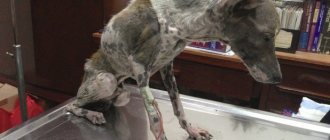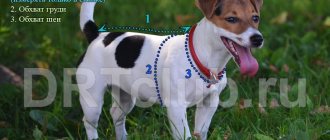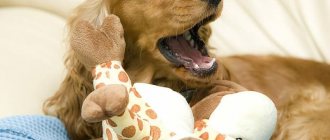What is rhinitis?
Rhinitis is an inflammation of the mucous membranes of the nose; it can be either an independent disease or a sign of other pathologies, for example, infection or allergies. There are several types of disease:
- Spicy. The symptoms are pronounced, the condition occurs against the background of infection with a virus or bacteria.
- Chronic. Appears as a consequence of prolonged exposure to adverse environmental factors or as a complication of the acute form.
- Vasomotor. The reaction occurs at the level of reflexes.
- Allergic. The mucous membranes are sensitive to allergens in the external environment (pollen, dust, etc.).
Many people put rhinitis in dogs and a runny nose on the same level, but in fact, nasal discharge is only a symptom of the disease. This type of disease is called catarrhal rhinitis.
Causes of runny nose in dogs
The condition occurs for many reasons, most of them are similar to human ones:
- Cold. Animals, just like people, react to hypothermia and drafts. If the dog walked for a long time in bad weather, suddenly left a hot apartment into the cold, slept on a cold floor, the body’s thermoregulation is disrupted, a runny nose, fever, sometimes sneezing, coughing, and fever occur.
- Infection or virus infection. In this case, the first two to three days the discharge will be abundant, liquid and transparent. Next, the green (yellow) snot will become thicker, and the dog will begin to grunt. Your pet may also suffer from conjunctivitis, stool disorders, and vomiting.
- Allergic rhinitis is a reaction of the immune system to an irritant. Most often it is dust, pollen, specific scents, chemicals or shampoos. Clear snot flows, accompanied by redness of the eyes, coughing, and sneezing. Diarrhea and difficulty breathing occur less frequently.
- Aggressive odors can cause a short-term runny nose. The pet will scratch its face with its paws, sneeze, and turn away.
- Foreign object in the respiratory tract. Dogs explore the world through their sense of smell, so it's not surprising that they might accidentally inhale a small object. The dog will try to get rid of it, sneezing, rubbing his nose, shaking his head. Discharge will be observed only from one nostril; if it is damaged, blood may be present in the mucus.
- The presence of neoplasms in the nasal passages (polyps, cysts, tumors). In this case, breathing is difficult, the animal will sniffle, grunt, breathe through its mouth, often rub its face, and pain will appear.
- Mechanical damage, congenital pathologies (fracture of the nose or jaw, cleft palate).
Rhinitis is often caused by weakened immunity.
The body's protective reactions are reduced in young and elderly individuals, pets suffering from kidney, liver or heart diseases, endocrine and genitourinary systems, infection with fleas or worms. Breeds with a flattened muzzle, such as Shar-Peis and Pugs, are more likely to suffer from a runny nose.
Why does a dog have snot?
- One of the main reasons for the appearance of discharge is allergies. Allergic rhinitis can be triggered by anything - plant pollen, new types of food, a collar, cosmetic care products, insect bites. In this case, the snot is usually clear and watery. Allergic rhinitis also causes watery eyes, sneezing, itching, and even difficulty breathing.
- Often dogs inhale various objects through their noses, which successfully get stuck in the nasal passages. In this case, not only mucus may be released, but also blood.
- Another common cause of snot is a viral infection. A dog catches a cold and gets sick just like a person.
- Hot air from a hair dryer, acrid smoke, toxic odor - all this can cause increased mucus secretion.
- Snot appears after long winter walks simply because the dog is cold.
Some dog breeds (for example, pugs, bulldogs, Pekingese) have naturally narrow nasal passages. This natural defect often prevents them from breathing through their nose, and the dog is forced to breathe through their mouth. At the same time, snot flows, often foamy. If desired, this situation can be corrected surgically. In any case, the owners of these dogs should be more careful about the health of their pets and immediately begin treatment for a runny nose. If this is not done, a common symptom can develop into a chronic disease.
Symptoms of rhinitis
While describing the possible causes of the problem, we briefly mentioned the signs of a particular disease. Symptoms may vary, but general features of the disease can be identified:
- presence of nasal discharge (intensity and consistency vary);
- difficulty breathing (you can hear wheezing, snoring in your sleep);
- the dog constantly tries to help itself by touching its nose with its paws;
- sneezing;
- deterioration of smell.
Apathy, poor appetite, and tearfulness also often appear. With a prolonged runny nose, crusts form on the nose. Possible increased body temperature, diarrhea, nausea.
Purulent (green) and catarrhal (yellow-green, mucous snot)
Snot, mucous or purulent, is usually a symptom of serious canine diseases. Of course, nasal discharge is not the only sign of infectious diseases that require urgent medical attention. Nasal discharge adds to other troubles.
The most common primary causes of a runny nose with the release of mucous (catarrhal) and purulent snot in dogs are adenovirus and canine distemper (distemper). Considering the unfavorable epidemic situation, tuberculosis can also be considered a common cause of snot.
How to treat runny nose in dogs at home?
You can treat snot in a dog at home, but a doctor must still prescribe it. He will determine the cause of rhinitis, prescribe medications in accordance with it, and, if necessary, take additional tests. Before the doctor arrives, the owner can do the following:
- A flashlight will be a great help to examine your pet. Assess the presence of discharge, its color and consistency, and intensity. Observe your dog for other symptoms. You will tell the doctor about all this.
- Clear your nose of mucus and crusts. To do this, wrap gauze or a cotton pad around your finger and, if necessary, moisten it with warm water.
- You can give your dog a chamomile decoction or treat the nasal passages with it. Taking an infusion of the herb internally soothes, applying it to the mucous membranes relieves itching and has an antiseptic effect.
- Make sure that the animal does not aggravate its condition by being in a draft or frost. Walking your dog when you have a runny nose is minimal.
- Offer your pet to drink more, preferably warm water. The food remains familiar.
The doctor will prescribe medication. Depending on the provoking factor, it may be necessary to exclude the allergen from the diet or the external environment, take antihistamines, remove a foreign body from the passages, or surgically remove tumors. But in most cases, a runny nose is caused by a cold, then nasal medications, warming and rinsing the sinuses are most often used to relieve the symptom.
Nasal drops
The most famous nasal drops for a runny nose for dogs are Maxidin. Doctors allow you to give them yourself, the main thing is to take into account the instructions for use. The drug has an antiviral and immunomodulatory effect. Used in the treatment of plague, parvovirus, enteritis, and helminthiasis. They help with skin diseases and are often prescribed as a preventive measure. If you start giving Maxidin at the first appearance of snot, you can prevent the spread of infection. Drop the solution 2 drops 3 times a day.
Another well-known remedy is Anandin. An intranasal drug used to treat rhinitis and conjunctivitis; accordingly, it should be instilled into the nose or eyes, depending on the problem. For a runny nose, it is recommended to use the product three times a day, the dose depends on the weight of the animal, ranging from 1 to 4 drops. Long-term therapy is addictive, so the duration of the course is no more than 14 days.
The use of human drops such as Naphthyzin or Sanorin is strictly prohibited. In the chronic form of the disease, you can drip menthol oil.
Warming up
One of the effective methods of facilitating an animal's breathing is warming up. You need to take a sock or scarf, heat salt or sand in a dry frying pan, pour it into the fabric. The compress is applied to the bridge of the nose for 3-4 minutes. Remember, it is better to do short-term but frequent procedures. If home treatment is not enough, physical therapy can be provided through a veterinary clinic.
Do not overheat the salt; too hot a product can cause burns.
Washing
It is necessary to rinse your dog's nose when he has a runny nose. Firstly, it cleanses the airways and removes mucus. Secondly, it is a preventive measure against the spread of infection. You can use pharmaceutical remedies or traditional methods, including:
- Soda solution, prepared at the rate of 1 tbsp. water for 1 tsp. sodium carbonate. The liquid should be warm. On the advice of a doctor, you can add a few drops of iodine to the mixture.
- Infusions of chamomile, St. John's wort, coltsfoot, violet and calendula are used. They soothe and disinfect mucous membranes. Add 1 tsp to a glass of boiling water. herbs, let it brew, cool and strain the solution.
- Beetroot juice for instillation is diluted with water in a 1:1 ratio.
- Some owners use onion juice to treat a runny nose, but you need to be careful with it; sensitive mucous membranes may become irritated. The secretion of one vegetable is squeezed out and mixed with water in equal parts. Cotton swabs are soaked in the solution and inserted into the nostrils for 10-15 minutes. The duration of treatment depends on the severity of symptoms.
- It is allowed to use sea water for washing: Aqua Maris, Aqualor, Dolphin.
- On the advice of a doctor, a solution of furatsilin (0.1%) is used.
Whatever medicine or remedy you choose, first assess the dog's condition. If the snot flows, you can limit yourself to simple rinsing. If your nose is stuffy or a lot of crusts have formed, you must first soften them. To do this, use turundas with petroleum jelly, glycerin, and 3% hydrogen peroxide. Oxolinic ointment has a softening and antiseptic effect; it is effectively used at the first signs of a cold.
It is allowed to use Evamenol ointment. Its composition is completely natural: menthol, eucalyptus oil, petroleum jelly. It is most convenient to apply the product with cotton swabs; keep in mind that dogs do not like such procedures, so it will be good if someone can hold the dog.
In the chronic form of the disease, on the contrary, it is necessary to dry the skin around the nose. For this purpose, special powders are prescribed, including streptocide powder.
How to treat colds
If the cause of your dog’s snot is a cold and hypothermia, the principle of treatment changes. Here are some effective ways to quickly and painlessly get rid of a runny nose in a dog.
- Dissolve the streptocide tablet in a small amount of water. After this, using a pipette, drop 2 drops of the prepared solution into each nostril of the dog. This will ease your pet's condition if the cause of snot is a viral cold.
- Another excellent remedy for a runny nose is onion juice. Fresh onions need to be chopped and juice squeezed out of them. It is best to soak cotton swabs in this juice and place them in the dog’s nose. However, not every dog can withstand this procedure, so in most cases it is easier to drop a few drops of onion juice diluted in half with water into each nostril.
- You can also drop beetroot juice into the animal's nose. It is diluted with boiled water and instilled into each nostril 3-4 times a day.
- If the snot is thick, yellow or green, you can treat the dog with Pinosol. Place 2-3 drops into each nostril several times a day and very soon your dog will come to his senses.
- Another excellent remedy for fighting snot is Derinat nasal drops. This medicine copes well with bacteria, viruses and infection.
- Many dog breeders actively use vitamin A in liquid form to combat the common cold. It is sold in pharmacies in ampoules. It not only suppresses the virus, but also softens and moisturizes the nasal mucosa.
If your dog has a cold, you need to make sure the room is cool. Take care of the air humidity, because dry air dries out the mucous membrane, which leads to the formation of crusts. Let your dog drink more. If you add a spoonful of honey to your pet's water, she will happily drink the whole bowl. After all, drinking plenty of fluids helps eliminate the virus from the body as quickly as possible. In addition, honey is useful for strengthening the immune system.
When dealing with snot on your own, it is very important to monitor the general health of the dog. If your pet has lost its appetite, if it is weak and apathetic, you should urgently consult a doctor. Sometimes snot can be a symptom of a serious illness, such as plague or tuberculosis. You can treat your dog for snot only if nothing else bothers him other than a runny nose. Take care of your pet and respond to its symptoms in a timely manner.
What to do if your dog grunts?
If there are no obvious symptoms of a cold or allergy, but the dog sniffles or snores in its sleep, it is necessary to find out the cause of the phenomenon and begin appropriate treatment:
- Polyps and other neoplasms. Small growths may not be noticed; only difficulty breathing will indicate their presence. When large tumors appear, the teeth will begin to loosen, frequent nosebleeds will occur, and in the later stages the muzzle will become deformed. The problem cannot be solved with pills; surgical intervention is necessary.
- Adenovirus is one of the common and dangerous infections, one of the symptoms of which is rhinitis. The discharge will be cloudy in color and a frequent cough will begin. The disease is only combated by antibiotics and supportive care.
- Allergic rhinitis can only be treated under medical supervision. If the allergen can be excluded, this must be done; if not, for example, a reaction to pollen occurs, the veterinarian will prescribe a course of treatment with antihistamines. In this case, the owner will only need to rinse the pet’s nose.
The occurrence of rhinitis is a signal to the breeder that the pet’s immune system is weakened and needs to be strengthened. Often in dogs of small breeds the body’s protective properties do not cope. They need to be stimulated with vitamins (A, E, C, group B), the veterinarian can additionally prescribe immunomodulators (Immunofan, Immunal, Cycloferon, Gamavit).
Video: how to treat a runny nose (rhinitis) and snot in a dog at home?
Forms of rhinitis and methods of its treatment
According to the specifics of its course, rhinitis is divided into two types:
- Acute
- provoked by widespread irritation of the mucous membranes: temperature changes, mild colds, irritation from smoke, dust or mechanical particles. It occurs in a mild form, usually does not reach the second stage, treatment lasts from 7 to 14 days.
- Chronic
– a consequence of allergies or other abnormalities. It responds well to treatment, but occurs again after a short period of time. For complete relief, it is necessary to identify the disease, the symptom of which is rhinitis, and then determine how to treat the animal.
Rhinitis is not a dangerous disease, but diagnosing the root causes is associated with many errors. If you doubt the diagnosis or observe negative trends, exclude drug treatment and consult a doctor.
Let's look at how and what to treat a dog's runny nose, in reverse order, starting from the advanced stage:
1.
Walking time is reduced as much as possible, drafts are eliminated in the home, and the dog’s area is insulated. Macroelements and foods containing vitamins A and E are added to the diet. Warm drinks are a must, preferably milk.
2.
The bridge of the nose is warmed with warm sand, preferably not for long, but often.
3.
Dried mucus crusts are removed once a day, more often if necessary. Ideally, you want there to be no crusts at all. To soften, you can use warm water, saline solution, hydrogen peroxide diluted in water (concentration no more than 3%). After the procedure, Vaseline, oxolinic ointment or a hypoallergenic antiseptic cream is applied to the wings of the nose.
People easily succumb to various infections and diseases. Unfortunately, pets are no less vulnerable to environmental conditions. Sometimes it is even difficult to understand whether a pet is sick or not. In animals, even a common cold progresses quickly. For example, dogs catch a runny nose most easily. Many owners then panic and have no idea what to do. But everything is not as scary as it seems.
It is worth saying that due to the physical characteristics of the physique, some dog breeds are more prone to developing a runny nose. These are, for example, pugs. But others can easily pick it up too. This usually manifests itself as a reaction to the cooling of the body, with rapid transitions of contrasting temperatures. Rhinitis is especially a concern for dogs in the spring or fall.
But weather is not the only factor. Quite often, rhinitis provokes the entry of irritating substances, smoke during fires, and hot air into the respiratory tract. Sometimes various foreign particles, for example, spikelets of plants, may end up in the nasal cavity.
In fact, a runny nose in dogs is a common inflammation of the nasal mucosa. Rhinitis is often divided into 2 groups: primary rhinitis and secondary rhinitis. Acute runny nose in dogs is provoked only by severe hypothermia or a sharp change in air temperature. For example, a Russian hunting spaniel may become ill while hunting in damp, damp terrain. Some decorative dogs tend to have a runny nose due to changing climatic conditions.
In some cases, a runny nose in a dog is not a separate disease, but just one of the symptoms, for example, of plague or inflammation of the pharynx. But an advanced runny nose in a dog can develop into a more complex form and cause inflammation of the animal’s upper respiratory tract.
Prevention of runny nose in dogs
In most cases, inflammation of the mucous membranes of the nose is caused by a cold. It can be easily prevented if you follow these recommendations:
- Provide the animal with proper care: a balanced diet and sufficient exercise. Remember that if you feed your pet natural food, it is better to give additional mineral complexes. If you prefer dry food, buy professional brands. Always consider your friend's breed; Jack Russell Terriers and Corgis require different levels of exercise.
- Walk your animal regularly (at least 2 times a day), with the exception of bad weather.
- Avoid hypothermia at home and outside. In the apartment, the dog should have a bed; it is located in a place protected from drafts. The dog is not taken for a walk after bathing; in the cold season, insulated overalls are worn.
- Hardening helps strengthen the immune system and improves the general condition of the body. The main thing is to gradually increase the time you walk in the cold.
- Do not ignore annual vaccinations, they strengthen the immune system and protect against the most dangerous infections. It is also advisable to take your dog to the veterinarian once a year and undergo general tests.
- A runny nose can be a symptom of a viral disease that was contracted from another animal. Try to protect your pet from contact with sick individuals.
Following these recommendations will make your pet's body stronger. If you are all faced with rhinitis, do not delay treatment, do not allow the disease to progress.










